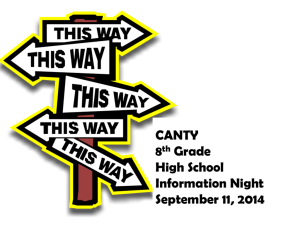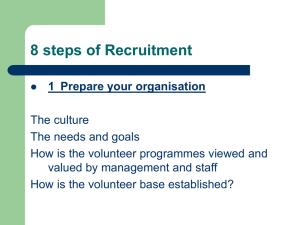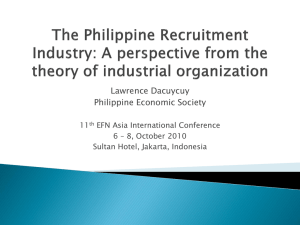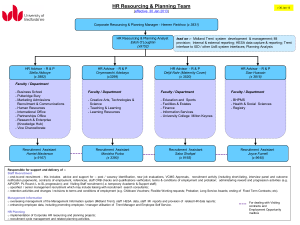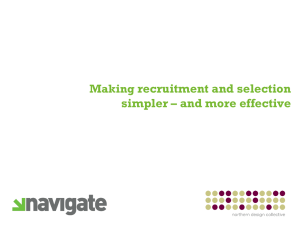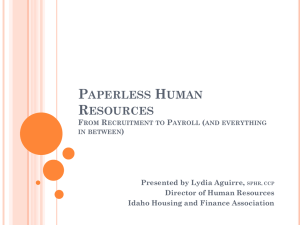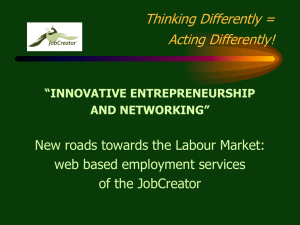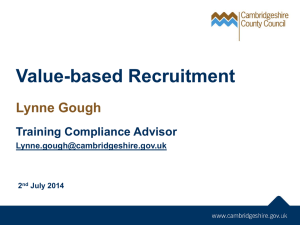Session A10 Powerpoint
advertisement
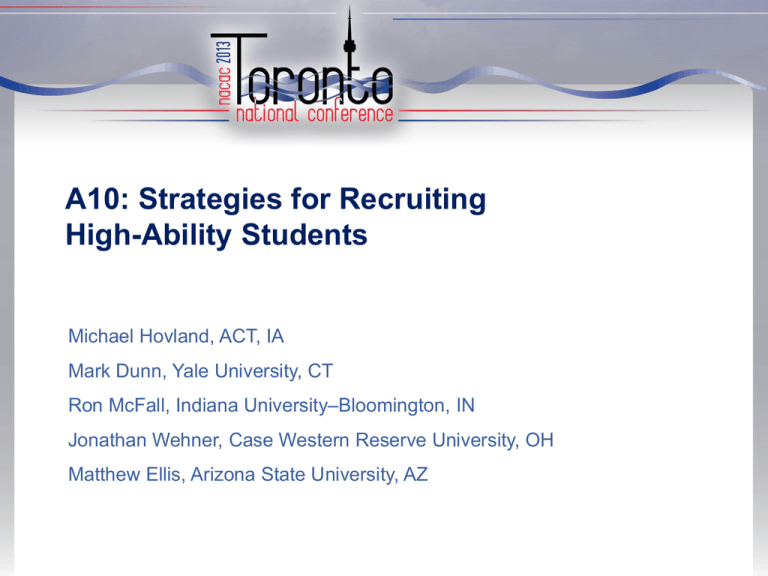
A10: Strategies for Recruiting High-Ability Students Michael Hovland, ACT, IA Mark Dunn, Yale University, CT Ron McFall, Indiana University–Bloomington, IN Jonathan Wehner, Case Western Reserve University, OH Matthew Ellis, Arizona State University, AZ Focus of Today’s Session • We’ll discuss how home location, family income, level of parent education, and student degree goals affect the enrollment preferences and the enrollment behaviors of high-ability students • We’ll look at the academic interests of high-ability students • We’ll discuss college environments where highability students thrive and recruitment strategies to attract them Pool Size for Research • High School Graduating Class of 2012 – 1,666,017 ACT-tested students – 1,172,602 enrolled in college (70.4%) – 213,426 ACT-tested with ACT Comp. Score of 28-36 – 184,571 enrolled in college (86.5%) • We have indications that the number of students scoring 28-36 has grown significantly in the past several years Definition of Selectivity for This Research The approximate mid-point ACT Composite Score for Enrolled Students: • Highly selective ACT Comp >=28 • Moderately selective ACT Comp 24-27 • Less selective ACT Comp <=23 • Test score not required – Combination of open admission and a few test optional Limitations of the Research Behind Today’s Presentation • A high percentage of high-ability students enroll at highly selective institutions • But we don’t have data on where students apply and whether or not they are admitted • So, we don’t know whether some high-ability students did not attend highly-selective institutions because they chose not to apply or because they weren’t admitted. Enrollment Intentions and Behaviors of High-Ability Students • We’ll be looking at ways we can identify student enrollment intentions and how the intentions carry through to actual enrollments • Institutions can use this information in two ways: – (1) You can target students more likely to enroll at your institution, or – (2) You can actively try to change the enrollment behaviors of high-ability students less likely to enroll Differentiating Characteristics Among High Ability Students • • • • Student home location Family Income Level of parent education Lifetime degree plans Selectivity Index Scores by ACT Composite Score Ranges 0-1.1 1.2-2.0 2.1-2.8 2.9-3.8 3.9-5.0 1-15 60 29 4 0 0 16-19 20-23 24-27 28-32 33-36 36 4 0 0 0 49 18 3 0 0 30 49 16 1 0 2 23 46 27 1 0 0 9 64 28 Selectivity of College Attended by ACT Composite Score, 2012 61 Highly Selective Moderately Selective Less Selective 0 1 3 28 3 22 13 3… 42 41 25 14 29 11 35 35 4 74 53 Test Score Not Required 34 1-15 16-19 20-23 21 24-27 ACT Composite Score Range 12 28-32 6 33-36 The Relationship Between Student Ability and College Selectivity • The data suggest clearly that as ability levels rise, students are more likely to attend more selective institutions • When that doesn’t happen, what are possible explanations? – We get important clues from differences in student enrollment intentions when examined by (1) where students live, (2) family income, (3) level of parent education, and (4) degree plans Home Location Is Predictive of Enrollment Behavior • There are clear differences in student enrollment preferences and behaviors by these locations: – Rural – Town – Suburban – Urban When we use the term “home location” in this presentation, we refer to the location of a student’s high school. Students with ACT Comp 28-36: Selectivity of Enrolled College by Home location Rural Town Suburban Urban Tests Not Required 12% 13% 10% 11% Less Moderately Highly Selective Selective Selective 20% 44% 24% 22% 42% 23% 9% 37% 43% 9% 39% 40% Characteristics of High-Ability Students from Rural Areas and Smaller Towns • In contrast to students from urban and suburban areas, high-ability students from rural areas and small towns: – Have lower median miles to enrolled college – Are less likely to enroll out of state – At all income levels, less likely to attend: • a highly selective college • a college out of state • a 4-year private college Parent/Guardian Level of Education Is Predictive of Enrollment Behavior • As parent/guardian level of education increases… – The percent of students who prefer to attend and attend out of state increases – Students prefer to attend and attend college farther from home – Students are more likely to attend selective and highly selective institutions Students with ACT Comp 28-36: Selectivity of Enrolled College by Level of Parent Education Not Required No College 16% Some College 16% Bachelors Deg 11% Graduate Deg 9% Less Moderately Highly Selective Selective Selective 21% 35% 28% 22% 40% 22% 14% 44% 31% 9% 39% 42% Student Degree Aspirations Are Predictive of Enrollment Behavior • As student degree aspirations increase… – The percent of students who prefer to attend and attend out of state increases – Students enroll farther from home – The percent of students who prefer to attend a 4-year private college increases Intended Educational Majors • High-ability students have very different educational major interests than lower-ability students Intended Major Categories by Frequency Rank for ACT Composite 28-36 Search Criteria to Identify the Enrollment Intentions of High-Ability Students • • • • • Student geographical location Preferred distance from home to campus Parent/guardian level of education Highest degree expected Family income Keys for Recruiting High-Ability Students: Less Selective Institutions • Less selective institutions will have more recruitment success with high ability students: – Who live in-state and who live closer to campus – Who prefer to attend college closer to home – Who live in rural areas and smaller towns – From lower and middle-income families – With lower levels of parent education – With lower degree goals Keys for Recruiting High-Ability Students: More Selective Institutions • More selective institutions will have more recruitment success with high ability students: – Who prefer to attend college farther from home – Who live in suburban and urban areas – From higher income families – With higher levels of parent education – With higher degree goals • All of the above are especially true if you are recruiting out-of-state students Yale University Office of Undergraduate Admissions Mark Dunn ’07 Director of Outreach & Recruitment Yale University Office of Undergraduate Admissions Outreach Context Search: ~100,000 prospects per class (nearly all domestic) PSAT + ACT – 70% Cappex + Zinch - 15% Other Inquiries – 10% QuestBridge – 5% Applicants: ~ 30,000 freshman applicants per class Admitted Students: ~2,000 (6.8% admission rate) Freshman Class: ~1,350 (68% yield rate) Student Outreach Experience In-Person - Campus Visit - Evening Information Sessions - School Visits Mail + Web - Search Letter - Viewbook - Email Campaigns - Social Media + Virtual Tour Themes: • Authoritative but authentic student voice. • Accessibility of resources. • Peers as Yale’s best resource. My Mantra: “Talk to them like adults. Fun adults.” Student Outreach Experience In-Person - Campus Visit: ~15,000-20,000 prospects annually 3 Part Campus Visit Experience: 1. Information Session (No script. No PowerPoint.) 2. Campus Tour (No script. No assigned route. ) 3. Student Forum (No parents. No admissions officers. No trained students. “Discuss amongst yourselves”) The Secret Sauce? Trust. Student Outreach Experience Mail + Web - Search Letter – Mailed to ~80,000 prospects “Talk to them like adults.” Student Outreach Experience Mail + Web - Viewbook– sent to all search letter recipients. Student voices. Separate text, stats, and images. 125 pages. @prince_ocey says “Sifting through this junk college mail and found something worthwhile…it’s Yale University. Best college mail yet!!! #college #happy #yale #messy #awesome” Student Outreach Experience Mail + Web - Email Campaigns: Series of 4 to ~100,000 prospects. • Authoritative student voice (written in collaboration). • Much shorter and less linear than search letter, but still text-driven. • Includes social media nudges. • Capitalize on, but don’t exploit natural curiosity about selective admissions. “Talk to them like adults. Fun adults.” Student Outreach Experience Mail + Web - Social Media + Virtual Tour: • Facebook + Tumblr • • Produced in-house with students and admissions officers. • Tumbler posts = 2x Facebook. • Active engagement with university social media strategy. Virtual tour • Promoted in all emails. • Real Yale student guides. • Translations available. Supplemental Campaigns Low-Income - 2 postcards with average net price info + fee waiver guidelines. - Driven by Hoxby research. URM - Diversity Viewbook: - 17 pages. Not solely focused on racial/ethnic diversity STEM - Science & Engineering Viewbook - 45 pages. Focused on student, alumni and professor profiles. Our Perspective - The Yale name can make a student open our viewbook or email. Our job is open that student’s mind about Yale. - Academic strength/fit isn’t given, but it isn’t these students’ sole focus either. - Questions we try to answer before they’re asked: - - Who goes there? - What are classes like? - What is the real experience like? - What do students do for fun? - What do you look for in an application? - How could I ever – in a million years – afford to go there? Current students are the best salespeople. Facilitate these interactions and get out of the way. Indiana University Office of Scholarships Ron McFall Interim Director Indiana University - Bloomington • • • • Bloomington, IN Flagship campus Public research university Fall 2013 enrollment • 31,984 undergraduates • 58% resident • 42% non-resident Office of Scholarships • • • • • • Created in 2007 Result of new leadership and campus task force Scholarships were seen as “everyone’s job and no one’s job” New strategy to align award administration with changing recruitment goals Recruitment office targeting scholarship-eligible students Separate from Admissions and Financial Aid Enrollment Management Structure Office of Enrollment Management Vice Provost, David Johnson Associate Vice Provost & Registrar Administration & Fiscal Affairs Admissions Admissions Operations Office of the Registrar Student Financial Assistance Strategic Planning & Research Student Service Center Strategic Communication & Marketing Scholarships First Year Experience Programs Key Recruitment Strategies • • • • Merit scholarship recruitment Personalized outreach Scholar recruitment events Regional recruitment Merit Scholarship Recruitment • IU Achievement Scholarships • • • • • (new for 2014) Assessed at time of admission November 1 deadline Interactive award letter Replaces previous “automatic” model Projected 8,000+ offers for 2014 class • Selective Scholarship Application (SSA) • • • • • Custom online app used by top IU schools Built for student at time of admission November 1 deadline 22% of admits receive an SSA invitation Opportunity for additional offers and personal outreach Merit Scholarship Recruitment • IU Foundation Scholarships • • • • • Leverage donor funds for recruitment Modified award process and timeline Additional recruitment touch for yield Flexibility in targeting key markets New stewardship program for 2014 • Enhanced award communication • • • • Consolidated award letter March 1 scholarship posting date Focus on net cost and financial literacy Targeting scholars with known aid • • 21st Century Scholars Program Development of dynamic award notifications Personalized Communication • Stripes campaign • “You’ve Earned your Stripes” • Web/social media/print • Launch in late fall • IU scarf sent to over 3,500 top scholarship recipients • “Show us your Stripes” photo contest • Winner selected by current IU scholars Personalized Communication • State Campaign • • • • • • Interactive map and microsite Custom postcards Ten target markets National presence Introduce and inform Focus on key academic programs • Scholarship Advisory Committee (SAC) • • • • Current IU scholars Assist with recruitment, marketing, and other projects Attend events and speak with prospective students Personalized event follow up Scholar Recruitment Events • IU Game Days • • • • • • Football tailgate event for high ability rising seniors Free tickets, t-shirts, and other IU freebies Prospects and admits Campus partners and admissions Mingle with current IU students “Snap a Scholar” • VIP Visits • • • Personalized campus visit day program Meetings with faculty and opportunity to attend an IU lecture Lunch with current students and staff Scholar Recruitment Events • IU Scholar Receptions • • • • • • Signature yield event Formal celebration of scholarship recipients Speech from Director, Vice Provost, and current student Highlight key academic programs Gifts for students and families in attendance Seven markets annually • South Florida and Los Angeles new for 2014 Regional Recruitment • New staff (Admissions) placed in Chicago, California, and New York • Strengthens pipeline • Promotes awareness of programs • Hoosier Hospitality • Hosted by Admissions • Targeted populations • Pilot year - Chicago and New York • Dynamic region-specific messaging • Market trends • SAC event follow-up for multiple key markets Outcomes SAT Composite – Undergraduate Beginner Cohort 1230 1217 1220 1210 1206 1203 1200 1202 1199 1190 1180 1170 1174 1160 1150 2008 2009 2010 2011 2012 2013 Outcomes • Improved class profile • • 2013 class is most academically talented in IU history Coincides with overall enrollment growth • Merit scholarship impact • • Substantial SSA growth in completed applications (24%) Positive yield trends for targeted populations (donor funds) • Hutton Honors College profile • • 29% growth for incoming class over 2012 Largest freshman class in Honors College history (1,050) • Influential scholar recruitment events • Strong deposit rates for IU Scholar Receptions • Indianapolis (81%), Cincinnati (69%), and Chicago (67%) • Growth in key non-resident markets • • 1 of of every 7 incoming freshmen now from Chicago area 17% app growth for 2013 in our key non-resident markets Future Directions • • • • • Development and growth of non-resident markets Deeper yield assessment on recipient populations Expanded CRM initiatives • New parent communications • Innovate, not saturate Leverage changing profile Further utilize data to shift campus scholarship culture 4,400 undergraduate students Arts and Sciences; Engineering; Nursing; Business Management ACT Middle 50%: 29-33 Recruiting to Desirable Programs Intended Major Categories by Frequency Rank for ACT Composite 28-36: • Undecided • Health Sci. & Techno. • Engineering • Sciences: Biological and Physical Recruiting to Desirable Programs • Less than 25% of our students are outside the listed range. • Competing with other top programs for high ability students. • Campaigns introduced after dropping yield or applications in key areas. Recruiting to Desirable Programs CWRU direct mail campaign: • 3 campaigns: Nursing, Engineering, Science and Mathematics • Fall senior year • Multi-touch • Focused on program differentiators Recruiting to Desirable Programs Email campaigns: • 3 campaigns: Nursing, Management, Pre-med • Bi-monthly • Highlighting program differentiators, rankings, current events Applications by Category 7000 5348 6000 4888 5000 4000 3000 6645 6269 3574 4976 4292 Nursing Engineering Science/Math/Pre-prof 2858 2000 1000 269 495 378 529 0 2010 2011 2012 2013 Retain High-Ability Students Weekly email newsletter: • Specifically to engage first-year students • Delivered Thursday evening • 9 stories, 1 video • Focused on navigating campus resources and events taking place the following week Retain High-Ability Students First-year portal: • Mirrors stories from newsletter • Divided into categories: live – housing, student activities, neighborhood life; manage – billing, financial aid, registration; learn – academic programs • Internal marketing Arizona State University A New American University Matthew Ellis Director of Freshman Admission Arizona State University Access • • • • • • 76,000 total enrollment 54,333 undergraduates 38,712 freshman applicants 27,488 admits 10,377 incoming freshmen 58% resident / 42% nonresident • 5 campus locations General University Admission Criteria 16 core competencies & AZ Residents Non-residents • 63% of residents in the top quarter of their class • 31% first generation • 25.6% from low income households Excellence 1,500+ freshman entering Barrett, the Honors College 4,100+ total program enrollment • • • • • 70% resident, 30% non-resident 700 National Merit, Hispanic and Achievement Scholars Approx 230 per incoming class Repeatedly ranked as a top honors program in the nation 5th in the nation for production of Fulbright Scholars • Tied with Yale and UC Berkeley Strategy • Work like one university…think like five • Very specific enrollment targets by program, college, campus, Barrett, geomarket and ability bands. • Specific National Scholar and Flinn Scholar goals • Targeted segmentation at search by academic program, campus environment and ability. • +500,000 suspects – 24 ability and environment segments, then interests and geomarket • Integrated multi-source marketing initiatives • Cooperative recruitment teams across university departments • High touch personal attention • 120,000 outbound personal phone calls • Residential college model influences experienced based marketing initiatives Plans • • • • Search • 8 email and 2 print cycle • Travel: 1,600 high school visits and college fairs in the fall • 25 nationwide ASU events Prospect • High variable content email campaign / 7-10 mailings • Monthly program/college communication • VIP program Applicant • Multi-step rapid response personal contact model in CRM Admit • Combined university and admitted college communication flow • Private social network • Enrollment coaching program Plans • • • • • High ability campus visit fly-ins Personal communication from the president and the provost Personally selected books to top admits College based academy programs Experience and outcomes heavy messaging • Top 5 university for recruiting graduates –Wall Street Journal • Top 100 university in the world • Center for World University Rankings • Academic Rankings of World Universities • 5th for Fulbright Scholars • Undergraduate Research • Successful alumni • Top university for student entrepreneurship • Phoenix as an internship capital
